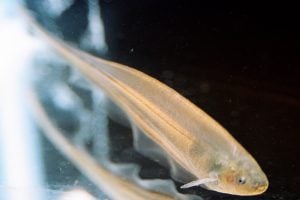
A team of researchers, led by Noah Cowan, professor of mechanical engineering, is blending neuroscience, math, and engineering to decode how animals decide when to gather information about their environment and when to act on it. Recording the brain activity of glass knifefish, a type of weakly electric fish which alternates between swift bursts of sensing activity and slower, task-driven behaviors, the team believes this research has potential to guide robots in uncertain terrains or unlock secrets of the brain.
The team’s findings were funded by the Collaborative Research in Computational Neuroscience (CRCNS) program—a joint initiative of the National Institutes of Health (NIH) and the National Science Foundation (NSF) that supports interdisciplinary research.
“I’m excited to have this dream team of mathematicians, engineers, and neuroscientists to assemble behind this problem,” Cowan said. “My lab at Hopkins has struggled to make sense of these movements for over a decade, and this team puts us on a path to finally decode the neural mechanisms animals use to switch gears between gathering task information, on the one hand, and getting the task done, on the other.”
The collaborative team includes Eric Fortune, associate professor of biological sciences at the New Jersey Institute of Technology (NJIT), Kathleen Hoffman, professor of mathematics and statistics at the University of Maryland, Baltimore County (UMBC), and Andrew Lamperski, associate professor of electrical engineering at the University of Minnesota.

Noah Cowan
The new project builds on the same team’s prior research, published in 2023 in Nature Machine Intelligence, which revealed similar decision-making patterns across species, from amoebas to humans. In that study, the team conducted experiments in Cowan’s lab to analyze the swimming behavior of glass knifefish, which navigates dark waters by using self-generated electric fields. Study lead author Debojyoti Biswas, postdoctoral scholar in Cowan’s lab, compared the behavior of 11 other species, including bats, mice, moths, and humans, uncovering remarkably similar strategies for solving the question of how animals explore versus exploit their environment.
That research showed that animals don’t constantly scan their environment, but rather burst into action when needed, a strategy the team showed is both more economical and more effective.
“The hypothesis that we’re considering is that it’s based on some internal measure of uncertainty in the fish, meaning that if the fish isn’t sure if it’s inside the tube, it’s going to move so it can gather sensory information,” Hoffman said.
The team believes that discovering how animals decide when to move for sensing versus when to move to achieve a task could lead to significant advancements in robotics as a whole.
“Traditional engineering treats sensing and control as separate modules: sensors gather information, and controllers act upon it. In contrast, biological systems deliberately move to shape sensory feedback, blurring the line between sensing and action,” Biswas said. “The theory we are discovering behind active sensing, and its prevalence across species, can guide the design of more adaptive and efficient robotic systems.”
A version of this story was originally published on the UMBC website.